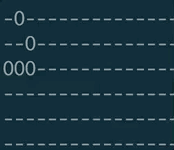An example run

The code
module Main where
import Prelude
import Effect (Effect)
import Effect.Console (log)
import Data.Tuple (Tuple(..))
import Data.Array.NonEmpty as NEA
import Data.Array as A
import Data.Foldable (elem, length)
import Data.String.Common as S
import Effect.Timer as T
import Control.MonadZero (guard)
maxX :: Int
maxX = 80
maxY :: Int
maxY = 10
type Y = Int
type X = Int
type Pos = Tuple Y X
-- Alive cells
type Board = Array Pos
block :: Board
block =
[ Tuple 0 0
, Tuple 0 1
, Tuple 1 0
, Tuple 1 1
]
blinker :: Board
blinker =
[ Tuple 0 1
, Tuple 1 1
, Tuple 2 1
]
glider :: Board
glider =
[ Tuple 0 1
, Tuple 1 2
, Tuple 2 0
, Tuple 2 1
, Tuple 2 2
]
showBoard :: Board -> String
showBoard board =
S.joinWith "\n" $ map showRow $ A.groupBy haveSameY $ A.sort allPositions
where
haveSameY :: Pos -> Pos -> Boolean
haveSameY (Tuple y1 _) (Tuple y2 _) = y1 == y2
showRow :: NEA.NonEmptyArray Pos -> String
showRow fs = S.joinWith "" $ NEA.toArray $ map (\f -> if elem f board then "O" else "X") fs
nextGeneration :: Board -> Board
nextGeneration board = do
p <- allPositions
guard $ willLive p board
pure p
allPositions :: Board
allPositions = do
y <- A.range 0 maxY
x <- A.range 0 maxX
pure $ Tuple y x
willLive :: Pos -> Board -> Boolean
willLive p board =
case Tuple (aliveNeighbors p board) (isAlive board p) of
Tuple 0 true -> false
Tuple 1 true -> false
Tuple 2 true -> true
Tuple 3 _ -> true
_ -> false
aliveNeighbors :: Pos -> Board -> Int
aliveNeighbors p board =
length $ A.filter (isAlive board) $ neighbors p
isAlive :: Board -> Pos -> Boolean
isAlive board p =
elem p board
neighbors :: Pos -> Array Pos
neighbors p1@(Tuple y1 x1) = do
y2 <- A.range (y1 - 1) (y1 + 1)
x2 <- A.range (x1 - 1) (x1 + 1)
let p2 = Tuple y2 x2
guard $ p1 /= p2
pure p2
loop :: Board -> Effect Unit
loop board = do
log "\x1B[2J\x1B[0f" -- clear terminal
log $ showBoard board
log ""
_ <- T.setTimeout 2000 (loop $ nextGeneration board)
pure unit
main :: Effect Unit
main = do
-- loop block
-- loop blinker
loop glider
pure unit
